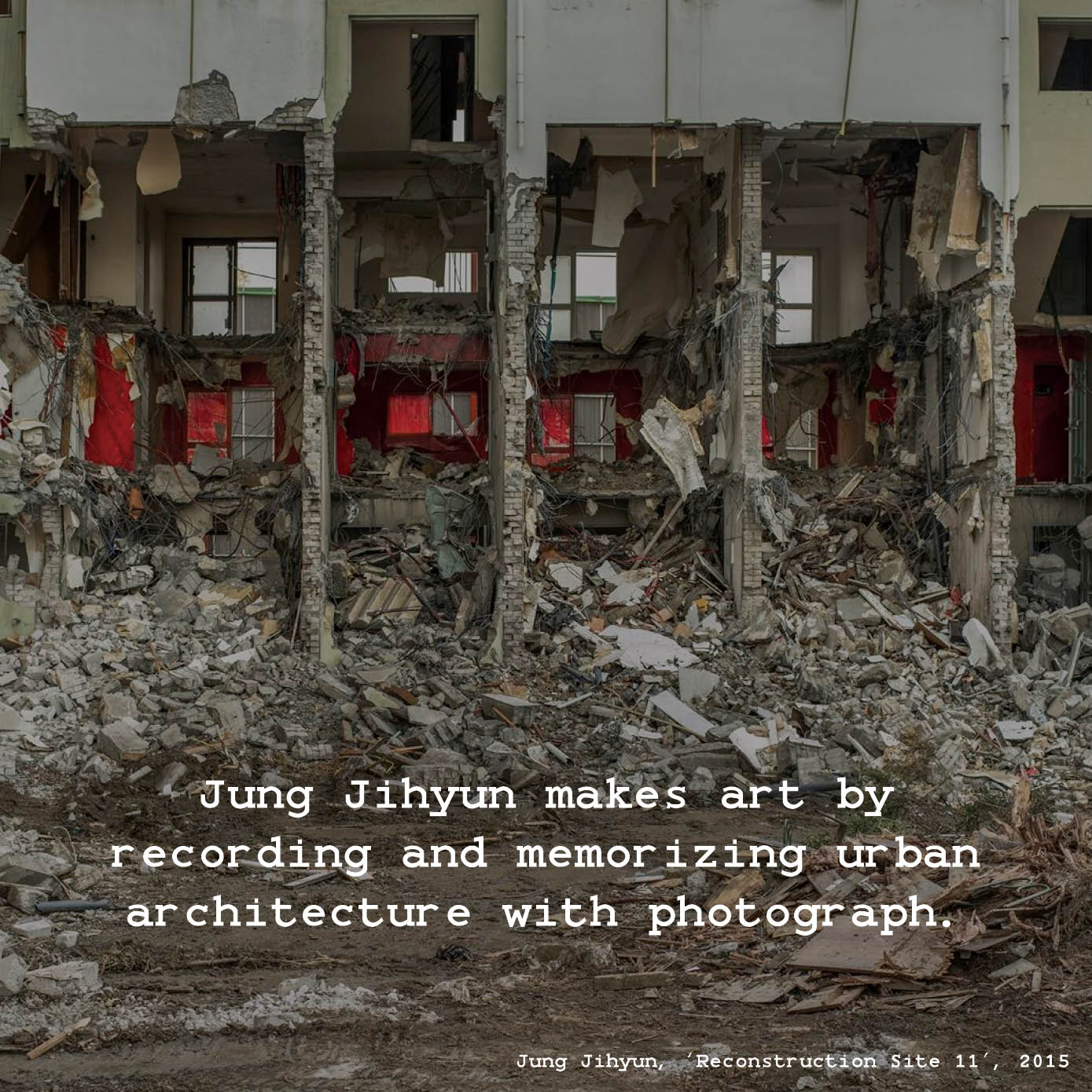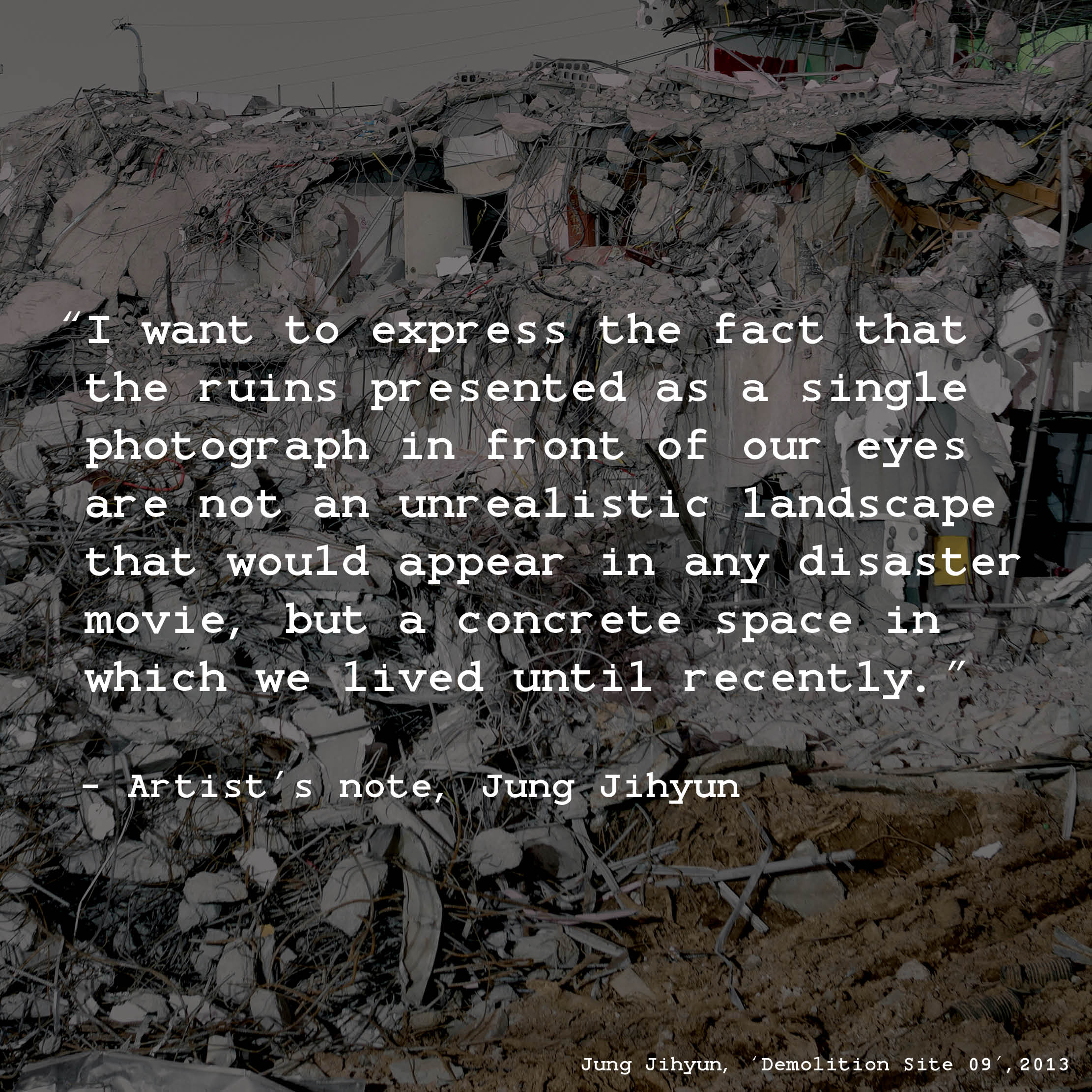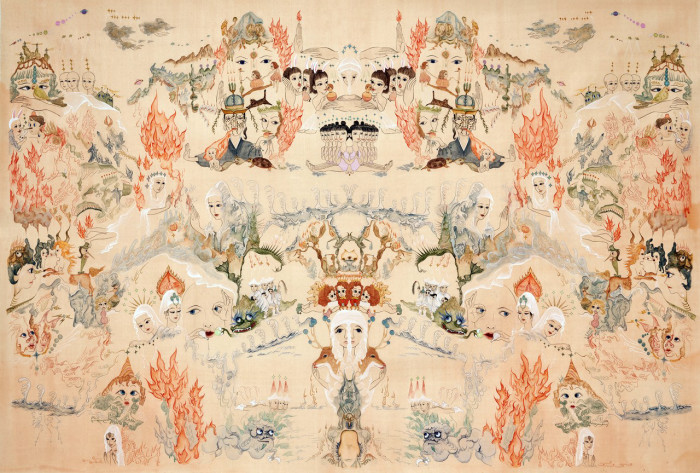 Title image of "The 22nd SONGEUN Art Award Exhibition." SONGEUN, Seoul. (December 21, 2022, to February 18, 2023) © SONGEUN Art and Cultural Foundation and the Artists. All rights reserved.
Title image of "The 22nd SONGEUN Art Award Exhibition." SONGEUN, Seoul. (December 21, 2022, to February 18, 2023) © SONGEUN Art and Cultural Foundation and the Artists. All rights reserved.Celebrating its 22nd edition, The SONGEUN Art Award Exhibition of the SONGEUN Art and Cultural Foundation features the works of 20 exceptional young artists from December 21, 2022, to February 18, 2023, to determine the 2022 winner this month.
There are 20 artists in the finals, including Jaewook Koh, Youngle Keem, Hyun-seok Kim, Rho Eunjoo, Grim Park, Rahm Park, Yunju Park, Hye-kyung Son, Sungseok Ahn, Anna Han, Jade Sujin Lee, Heejoon Lee, Jongwan Jang, Bokyung Chun, Hye-rim Jun, Hye-joo Jun, Jihyun Jung, Heemin Chung, Che Go Eun, and Wonhae Hwang.
Among the twenty artists, following the ten introduced last week, the remaining ten artists, from Jade Sujin Lee to Wonhae Hwang, are covered in this article.
 이수진(Jade Sujin Lee), '하울링 익스프레스 오버 하이퍼씨', 2022, 3채널 영상, 아연, 철, LED 모니터, LED라이트,가변설치, 9분 5초. ⓒSONGEUN Art and Cultural Foundation and the Artists. All rights reserved.
이수진(Jade Sujin Lee), '하울링 익스프레스 오버 하이퍼씨', 2022, 3채널 영상, 아연, 철, LED 모니터, LED라이트,가변설치, 9분 5초. ⓒSONGEUN Art and Cultural Foundation and the Artists. All rights reserved.Jade Sujin Lee (b. 1980) focuses on values disappearing due to urbanization and industrialization through video, installation, and audience-participatory performances. In SONGEUN’s exhibition, the artist created a transcendental habitat through her video and installation work. Lee imagines a world with various possibilities by creating a fictional territory where wild animals and microorganisms, sound, vibration, flow, and materiality exist. The circular halls, walls, and stairs in the video contain light, sound, time, and the moon. The places appearing in the video are a stage where the objects dismantle boundaries and unfold future times.
 이희준(Heejoon Lee ), (왼) 'A Raindrop', 2022, 캔버스에 아크릴, 포토콜라주, 225x225cm, (오) 'The Rehearsal', 2022, 캔버스에 아크릴, 포토콜라주, 225x225cm. ⓒSONGEUN Art and Cultural Foundation and the Artists. All rights reserved.
이희준(Heejoon Lee ), (왼) 'A Raindrop', 2022, 캔버스에 아크릴, 포토콜라주, 225x225cm, (오) 'The Rehearsal', 2022, 캔버스에 아크릴, 포토콜라주, 225x225cm. ⓒSONGEUN Art and Cultural Foundation and the Artists. All rights reserved.Heejoon Lee (b. 1988) collects images of everyday life in the city, from nearby surroundings to overseas travel destinations, edits them using the photo collage technique, and creates abstract paintings by painting color fields. Three paintings and one installation work are presented in the exhibition, which expresses the places the artist has personally experienced or wants to visit. Among the four works, the artist remade Mining the Moon (2022) in a smaller size and reassembled it to create Reconstruction no.4 (2022), a sculptural piece. Through this attempt, the artist further expands his artistic practices to present a more diversified abstract experience.
 장종완(Jongwan Jang), '뉴 슈가_지옥으로 가는 길은 선의로 포장되어 있다', 2022, 리넨에 아크릴릭 과슈, 227.5x364.3cm. ⓒSONGEUN Art and Cultural Foundation and the Artists. All rights reserved.
장종완(Jongwan Jang), '뉴 슈가_지옥으로 가는 길은 선의로 포장되어 있다', 2022, 리넨에 아크릴릭 과슈, 227.5x364.3cm. ⓒSONGEUN Art and Cultural Foundation and the Artists. All rights reserved.Jongwan Jang (b. 1983) paints a utopia that someone might have imagined. Yet, the artist adds a sense of unfamiliarity and anxiety in the colorful, happy-looking images. Inspired by an article about bees disappearing in Korea, Jang created a large-scale painting that presents a world where all the anthropomorphized animals, seemingly living in a utopia, look like bees. Through the paintings, Jang asks the viewers to reconsider the problems created by humans by comically revealing a tragic situation that seems to be reached in the near future.
 전보경(Bokyung Chun), 'MiRRORING, 2022, 5채널 HD 영상, 13분. ⓒSONGEUN Art and Cultural Foundation and the Artists. All rights reserved.
전보경(Bokyung Chun), 'MiRRORING, 2022, 5채널 HD 영상, 13분. ⓒSONGEUN Art and Cultural Foundation and the Artists. All rights reserved.The works of Bokyung Chun (b. 1979) explore people’s gestures and reveal what kind of intense reality lies behind those gestures through video. Recently, the artist has been paying attention to the changing gestures of human labor being replaced by machines.
In this exhibition, Chun worked on questioning artificial intelligence, which is now possible to create, as well as questioning the uniqueness of human beings living with AI. Through the video, the artist explores the changing relationship between artificial intelligence and humans while they mirror each other (a psychological term for copying the behavior of others or a method of the real-time operation of copying data from one location to a local or remote storage medium).
 전혜림(Hye-rim Jun) '면면체-호작도', 2022, 캔버스틀 구조물 위에 캔버스천, 젯소, 아크릴, 유화, 234.7x224.5x167.5cm. ⓒSONGEUN Art and Cultural Foundation and the Artists. All rights reserved.
전혜림(Hye-rim Jun) '면면체-호작도', 2022, 캔버스틀 구조물 위에 캔버스천, 젯소, 아크릴, 유화, 234.7x224.5x167.5cm. ⓒSONGEUN Art and Cultural Foundation and the Artists. All rights reserved.Hye-rim Jun (b. 1982) has been utilizing images from classical iconography and contemporary icons to break the characteristics of conventional painting media and create works transformed in various ways. Jun has been exploring how the ideas that make up a painting are revealed through images. Although based on painting, Jun’s works are in various forms and shapes.
In SONGEUN’s exhibition, Jun presents a structure made of canvases that are painted on all sides, including the back and sides. The canvas structure is a self-standing painting work that is possible to fully appreciate to whole work only by walking around the artwork. Unlike the other artworks, Mt. Samdeung (2022) is a piece that hangs on the wall. The artist created a parallax on one screen by overlapping the three-part panoramic image into three layers.
 전혜주(Hye-joo Jun), 'Hummer', 2022, 표본테이블, 수집된 식물과 꽃가루 표본, 레퍼런스 이미지, 초지향성 스피커, 가변설치, 2채널 사운드. ⓒSONGEUN Art and Cultural Foundation and the Artists. All rights reserved.
전혜주(Hye-joo Jun), 'Hummer', 2022, 표본테이블, 수집된 식물과 꽃가루 표본, 레퍼런스 이미지, 초지향성 스피커, 가변설치, 2채널 사운드. ⓒSONGEUN Art and Cultural Foundation and the Artists. All rights reserved.Hye-joo Jun (b. 1985) creates audiovisual media work using various found objects, images, and sounds. Jun collects materials according to a specific theme to explore phenomena that are not easily recognized in everyday life. Jun thought that just as we are not ordinarily aware of pollen floating in the air, military weapon technology is becoming prevalent in our daily lives unwittingly. The artist compares the ecological cycle with military systems in her installation work. The artist attempts to reveal the fact that we easily forget about the influence of certain subjects as they slowly permeate our thoughts and bodies.
 정지현(Jihyun Jung), '컷슬로프 #6034', '컷슬로프 #6020', '컷슬로프 #6136,' 2022, 피그먼트 프린트에 실크스크린_90x70cm(왼쪽에서부터). ⓒSONGEUN Art and Cultural Foundation and the Artists. All rights reserved.
정지현(Jihyun Jung), '컷슬로프 #6034', '컷슬로프 #6020', '컷슬로프 #6136,' 2022, 피그먼트 프린트에 실크스크린_90x70cm(왼쪽에서부터). ⓒSONGEUN Art and Cultural Foundation and the Artists. All rights reserved.Jihyun Jung (b. 1983), who works with photography, intervenes in a construction site or demolition site in a redevelopment area where access is restricted to record the changing urban environment. Instead of simply photographing the landscape, he makes changes to these sites to emphasize the process of demolition and construction and capture the hidden stories surrounding the areas. In the exhibition, Jung photographs the sedimentary layer revealed by the excavation work to capture the accumulated temporality. He also uses the silkscreen technique on photographic paper to emphasize the materiality that digital photography cannot record, creating a work that has a three-dimensional effect with a certain texture.
 정희민(Heemin Chung), '연결된 댄서들과 들뜬 밤', 2022, 아크릴 미디엄에 잉크젯 전사, UV 프린트, 라이트박스에 실, 194×530×10cm. ⓒSONGEUN Art and Cultural Foundation and the Artists. All rights reserved.
정희민(Heemin Chung), '연결된 댄서들과 들뜬 밤', 2022, 아크릴 미디엄에 잉크젯 전사, UV 프린트, 라이트박스에 실, 194×530×10cm. ⓒSONGEUN Art and Cultural Foundation and the Artists. All rights reserved.By emphasizing matter, the works of Heemin Chung (b. 1987) reveal emotional issues faced by individuals living in an era where technology is prevalent and confront painting by challenging the conventional notions and techniques of the genre. In particular, Chung traces how technology creates our way of perceiving our lives and how it affects art.
In the lightbox work installed on the wall, the artist modeled enlarged flowers using acrylic. The artist recreated the texture of the flowers to reveal the things we sense today metaphorically. To the artist, the world we live in is a virtual place where everything flows in digital data or is expressed in images. Through her work, she questions the meaning of experiencing physical topics and how real matter is becoming digitized.
 최고은(Che Go Eun), '나의 른손이를 보셨습니까(물음표)', 2022, 시트지 프린트, 아크릴, UV프린트, 미러, 디크로익 필름, 라즈페리파이, 카메라, 250x150x350cm. ⓒSONGEUN Art and Cultural Foundation and the Artists. All rights reserved.
최고은(Che Go Eun), '나의 른손이를 보셨습니까(물음표)', 2022, 시트지 프린트, 아크릴, UV프린트, 미러, 디크로익 필름, 라즈페리파이, 카메라, 250x150x350cm. ⓒSONGEUN Art and Cultural Foundation and the Artists. All rights reserved.The works of Che Go Eun (b. 1988), which use images from video games, cartoons, and virtual images, study the social position of women in today’s society as well as forgotten women figures in history. Che also captures the image of Seoul surrounded by endlessly repeated advertisements. In the exhibition, Che reinterpreted the interior space of Korea’s elevators, where mirrors face each other, equipped with surveillance cameras, and filled with numerous advertisement stickers and videos. The artist believes that these advertisements spread standardized life. The artist invites visitors to step inside the exaggerated advertisement images, with the facing mirrors creating infinitely repeating reflections, to rethink our contemporary society.
 황원해(Wonhae Hwang), 'Unwind', 2022, 캔버스에 아크릴, 240x223cm. ⓒSONGEUN Art and Cultural Foundation and the Artists. All rights reserved.
황원해(Wonhae Hwang), 'Unwind', 2022, 캔버스에 아크릴, 240x223cm. ⓒSONGEUN Art and Cultural Foundation and the Artists. All rights reserved.Wonhae Hwang (b. 1989) observes the urban space and paints her emotions and thoughts about city life. In the paintings, the artist synthesizes architectural elements from the past and the present and overlaps urban geometric elements and patterns. The artist attempts to invoke conflicting urban sentiments unique to these areas, where people share the space but live individual lives and which have a dynamic environment yet have a cold-hearted society.
Hwang uses the most common image of cities, a square or module, to create works and add subjective emotions. The artist uses various techniques and materials, such as different brush strokes, airbrushes, and screen tones, to capture not only the three-dimensional exterior of the city but also the conflicting emotions she feels while observing the flat surface of a city. Through the works, the artist suggests that the viewer look at the city differently.




















